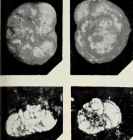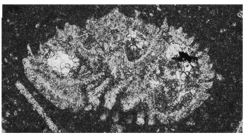Foraminifera taxon details
Rotalispira Hottinger, 2014 †
1252792 (urn:lsid:marinespecies.org:taxname:1252792)
accepted
Genus
Rotorbinella scarsellai Torre, 1966 † accepted as Rotalispira scarsellai (Torre, 1966) † (type by original designation)
marine, brackish, fresh, terrestrial
fossil only
feminine
Hottinger, L. (2014). Paleogene larger Rotaliid Foraminifera from the Western and Central Neotethys. <em>Springer, Berlin.</em> 191 p., available online at https://doi.org/10.1007/978-3-319-02853-8
page(s): p. 58 [details] Available for editors [request]
[request]
page(s): p. 58 [details] Available for editors
Description Small shells with an equatorial diameter around half a millimeter. The dorsal part of the shell is convex and evolute,...
Description Small shells with an equatorial diameter around half a millimeter. The dorsal part of the shell is convex and evolute, bears heavily limbate whorl sutures and slightly limbate or smooth chamber sutures. The latter are curved and bent backwards. The periphery is keeled in accordance with the limbate nature of the whorl suture. The equatorial to axial diameter ratio varies from about 1.5 to 1.75. There are 6 chambers in early, nepionic stages and 8–10 chambers in the last whorl. The only proloculus that is measurable has a diameter of 0.04 mm. The ventral side of the shell is flattened and presents a relatively narrow umbilicus, covered but not closed by long folia. Their thickened adaxial tips fuse to form an annular rim around the axis. There is no umbilical pile in the coiling axis of the shell. [details]
Hayward, B.W.; Le Coze, F.; Vachard, D.; Gross, O. (2024). World Foraminifera Database. Rotalispira Hottinger, 2014 †. Accessed at: https://www.marinespecies.org/Foraminifera/aphia.php?p=taxdetails&id=1252792 on 2024-04-18
Date
action
by
original description
Hottinger, L. (2014). Paleogene larger Rotaliid Foraminifera from the Western and Central Neotethys. <em>Springer, Berlin.</em> 191 p., available online at https://doi.org/10.1007/978-3-319-02853-8
page(s): p. 58 [details] Available for editors [request]
[request]
page(s): p. 58 [details] Available for editors
From editor or global species database
Description Small shells with an equatorial diameter around half a millimeter. The dorsal part of the shell is convex and evolute, bears heavily limbate whorl sutures and slightly limbate or smooth chamber sutures. The latter are curved and bent backwards. The periphery is keeled in accordance with the limbate nature of the whorl suture. The equatorial to axial diameter ratio varies from about 1.5 to 1.75. There are 6 chambers in early, nepionic stages and 8–10 chambers in the last whorl. The only proloculus that is measurable has a diameter of 0.04 mm. The ventral side of the shell is flattened and presents a relatively narrow umbilicus, covered but not closed by long folia. Their thickened adaxial tips fuse to form an annular rim around the axis. There is no umbilical pile in the coiling axis of the shell. [details]Remark This new genus is proposed here after the revision of Rotorbinella by Revets (2001) in order to stress the structural differences on the generic level: Rotalispira has an umbilical structure dominated by the extension of the foliar wall over at least half of the shell face. The foliar suture (between main chamber and foliar chamberlet) is thickened by secondary lamellation to form solid projections that are twisted and obliquely superposed like thick propeller blades. The thickened sutures on the umbilical side of the shell seem to match the thickened spiral suture on the dorsal side. The generic name reflects the dorsal aspect of the shell, dominated by the limbate spiral suture. Occasionally, the thickened foliar walls of the previous whorl support the folia of the next whorl. The main chamber lumina are separated from the foliar chamberlet lumina by an umbilical plate. There is a direct communication between subsequent foliar lumina forming a kind of spiral canal. The interlocular space is restricted to the adaxial umbilical part of the septum. There are no canal orifices on the dorsal side of the test. Rotalispira appears together with true Rotorbinella in the Late Cretaceous and might therefore represent a root of the lockhartiines that is separate from the rotaliines. [details]


